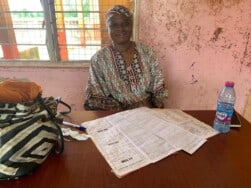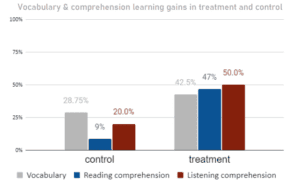The Exciting Impact of our Google Read Along Pilot on Girls’ English Proficiency
September 7th, 2023 | Stories
A baseline assessment of the English language proficiency of former out-of-school girls in Ghana showed that many students were struggling. For example, students in grade 5 read on average 4 words per minute, and were unable to respond to comprehension questions. Because schools in Ghana teach in English in grade 3 and above, this presents an obstacle to their education.
To address this challenge, World Education led a pilot to help students learn with Google’s Read Along App. Students built skills using the app by reading stories, playing games, and completing activities with the help of Diya, an in-app buddy who provides feedback and pronunciation help using text-to-speech technology. Girls received tablets through the pilot to practice reading on for 15 to 20 minutes every day, with support from a trained mentor teacher.
After participating in the pilot program for 3 months, their reading proficiency shows significant improvement, and girls, parents, and teachers are more engaged in learning.
Since we started using the tablet to learn, I have realized that I can now read, spell, and pronounce words which I could not before. I now know certain English words, especially names of animals and food. When I go to the market, I know the English name for most of the items I buy. Before, it was only the Dagbani names that I knew,” said Amina* , a participant in the pilot.
Teachers are also noticing improvements among their students who participated. “Most of the girls who are on the pilot project have improved in their academic work and some have overtaken their male counterparts who (initially) were doing better than them,” said one teacher. Another stated that “Amina* and her peers who participated in the pilot project developed interest in reading and making an effort to read anything written on the chalkboard. What is fascinating is the fact that they now know most of the things in the English language without me translating for them. I noticed also that they picked up reading and spelling faster than those other girls who did not participate in the program.”

Parents are also excited to see their children’s improved skills and enthusiasm for learning. As one participant’s father shared, “I did not get the opportunity to go to school, nor have I had someone to support me as my daughter has. This is why I decided she stays in school and learns instead of asking her to be with me on the farm during school hours. I do not have money to buy books for her to read. She told me the tablets contain a lot of stories which are helping her to read. I do not know how it works, but I know that my daughter’s interest in going to school has increased. She leaves early to be in school. She will always mention Diya and smile when she is home. Diya, she says, helps her pronounce difficult words.”
The end line assessment compared girls’ performance before and after the pilot, and in relation to the performance of a similar group of girls who did not participate in the pilot. We found that, on average, the girls in the pilot read 29 more words correctly per minute during the end line assessment than the baseline assessment. They could also read 40 letters or more in one minute, on average. While girls in grade 5 who did not participate in the pilot read on average 7.9 words more at the end line, girls who participated in the Read Along pilot read 39.6 more words compared to baseline.

The girls’ vocabulary and English comprehension improved significantly as well. They were able to, on average, name and pronounce 85.4% of the English vocabulary correctly, and answer approximately half of the reading and listening comprehension questions correctly.
Read the full impact evaluation report for further qualitative data on the experiences of teachers and students, as well as further exploration of attendance data and its link to learning gains.
World Education fosters enduring partnerships across regions and sectors to advance education outcomes for all. We offer education systems strengthening, program design and implementation, applied research and evaluation, capacity development, and policy development services.